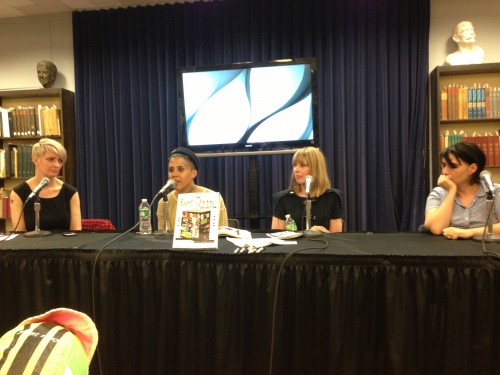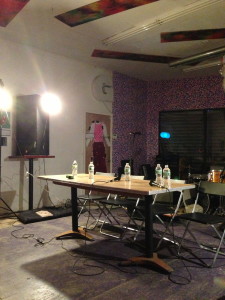On May 29, 2013 there were two back-to-back panel discussions, one in Manhattan, one in Brooklyn, which drew two different crowds of artists, feminists and leftists. To my knowledge, only two people attended both: myself and the journalist and author Sara Marcus.
At 6:30pm in the West Village, Kathleen Hanna, Joanna Fateman, Ramdasha Bikceem and archivist Lisa Darms took to the podium for an hour at the Fales Library at NYU to read from and discuss The Riot Grrrl Collection, an edited catalog of their donated archival materials published by the Feminist Press.
After the readings, the panel answered questions from the young women assembled, many students at the university, whose questions averaged out to say, what do we do now?
“I don’t really know how to be involved besides finding stuff in your community that you care about, and either going to meetings or making the art you want to make. I always say, I feel like I’ve had so much longevity to my career because I mixed something I care deeply about, which is ending violence against women, with something I really enjoy doing, which is making music,” Kathleen Hanna told the crowd.
“What has to happen now?” Joanna Fateman repeated a question from the audience, “Wow, that’s a killer.”
The panelists did their best to inspire, but also seemed to convey to the audience that the material before them is not a template for revolution, but rather, a source of inspiration for them, the next generation of women to make radical art and music and push boundaries.
 After 9pm in Bushwick, a packed room gathered for Silent Barn’s public meeting about women in DIY. On the panel were Sara Marcus (author of Girls to the Front: The True Story of the Riot Grrrl Revolution), Sari Rubinstein of Rubulad DIY parties, Rachel Nelson of DIY space Secret Project Robot / Happyfun Hideaway and Nina Mashurova of Silent Barn, moderated by Silent Barn project leader Alison Sirico. Alison asked, “Is DIY political?”
After 9pm in Bushwick, a packed room gathered for Silent Barn’s public meeting about women in DIY. On the panel were Sara Marcus (author of Girls to the Front: The True Story of the Riot Grrrl Revolution), Sari Rubinstein of Rubulad DIY parties, Rachel Nelson of DIY space Secret Project Robot / Happyfun Hideaway and Nina Mashurova of Silent Barn, moderated by Silent Barn project leader Alison Sirico. Alison asked, “Is DIY political?”
“It’s 100% political in one sense, at least for myself, you are affirming you desire something different in the world than actually how it exists and how it is given to you – so for me it is a political act in the sense that I really want to show people that I think there is a much different and more beautiful way that the world could be created,” answered Rachel.
Again, the room full of young women was bursting with questions about how to get involved, how to get other women to come out to see shows, attend events and how and why had these panelists been successful at it. Oh, and how does one do DIY sustainably?
Listen here
[display_podcast]
 The culmination of both discussions was: go do it, and you’ll figure it out. That was also true when the discussion turned to building relationships based on common interests across race, sexuality and class, which was far more present in the more diverse discussion at Silent Barn.
The culmination of both discussions was: go do it, and you’ll figure it out. That was also true when the discussion turned to building relationships based on common interests across race, sexuality and class, which was far more present in the more diverse discussion at Silent Barn.
“We can create our own world,” Sari, the pioneer and DIY stateswoman of the panel, told the crowd. The panelists suggested it’s a matter of learning from past mistakes, being smart about resources and moving forward with the exponentially larger underground that exists in Brooklyn today.
I emailed Sara about what she thought going from audience member to panelist at these events, both in one evening. Here’s what she wrote back.
Here’s how I felt about going from one to the other: When the audience members at Fales were asking the panelists what to do now, what the priorities for their activism should be, I couldn’t help thinking they were asking the wrong people, or maybe asking the right people the wrong question. I think I can understand why these were the questions on people’s minds. But I feel like young people who want to start something new need to be talking to one another first and foremost, and maybe talking to people who are a couple years older than them, in order to find focus and set an agenda. The most helpful questions to ask people who have longer histories in the movement might be more like “Here’s what we want to do, here are our concerns–how have people dealt with these in the past? What has worked, what have the challenges been? Here’s our plan–do you see any pitfalls here, anything we’re not accounting for?” I felt like the Silent Barn event was a marvelous example of this: of (mostly) younger people creating a community together and asking for input on this thing they were already working on. Also, the Silent Barn event seemed to draw a much more racially diverse group than the audience at Fales. (There’s much more to be said about that, but I’ll demur for the moment.) After the panel, I heard at least one participant say she wanted to convene a meeting that would enable more discussion, as opposed to the panel of putative “experts” and Q&A format of last night’s event. That made me extremely happy and hopeful.
Riot Grrrl history absolutely has to be documented, preserved, disseminated, spread. But the danger is that the culture and history can become a sort of fetish object, with people looking to the movement as a template, rather than as an inspiration and a source of lessons, ideas, and cautionary tales. The new book is open to both sorts of uses; it can’t legislate how people are going to read or understand it. I just wish more people from the Fales event had come over to Silent Barn afterward. It felt to me like a perfect double bill and I’m glad that you and I, at least, had the opportunity to experience it.
Luckily, you can too. The audio from both events is posted here in its entirety, to download it, open the download link in a new tab and save the page, then add it to your mp3 library. Each discussion is one hour long, the first hour is from NYU, the second, from Silent Barn. Tune in at 28 minutes to hear Kathleen read her Riot Grrrl manifesto. Since Sara was an audience member at NYU, she references the event in the Silent Barn discussion that begins at the one hour mark. The end of the night was rounded off by a great set by the band Habibi.

Be First to Comment